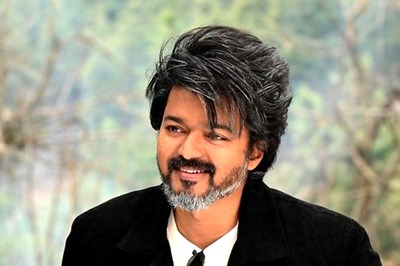
views
Vasudhaiva Kutumbakam! One Earth. One Family. One Future.
Taken from the Maha Upanishad, the motto promotes life or lifestyle for environment. Prime Minister Narendra Modi outlined Bharat’s vision for the world as the gavel was passed on and New Delhi assumed the presidency of the G20 from Indonesia.
Nearly 10 months later, leaders from more than 35 nations who were present at the G20 Leaders’ Summit in Delhi have not just memorised these words, they have witnessed it manifest. Bharat has emerged as the ‘Vishwamitra’ or friend of the world. Helped by emerging nations like Indonesia, Brazil and South Africa, G20 Sherpa Amitabh Kant was able to proudly proclaim that the Delhi Declaration, which ran into 38 pages, had unanimous consensus with no footnote or contested line added in any of the 80-plus paragraphs.
The ability to achieve consensus at a time of conflict in a deeply polarised world is landmark. This showcased Bharat’s ability to manage relationships and maintain friendships across the spectrum. Prime Minister Modi, as the main representative of ‘Vishwamitra Bharat’, then gave the ‘Vishwa Mantra’ of Sabka Saath, or inclusion. The inclusion of the African Union as a permanent member is the biggest testament of Sabka Saath.
Bharat helped G20 become Sabka G20. It is a slap on the face of all those who endeavoured to label PM Modi as “fascist” and Bharat under his leadership as “authoritarian”.
The G20 year of presidency, along with the summit in Delhi, is a shining example of Sabka Saath. Sixty cities played host to delegates, more than 210 meetings were held at these venues. The message of G20 and the spirit of Jan Bhagidari (people’s participation) was furthered with initiatives like Y20 and U20. G20 was democratised like never before. By the time the top leaders from across the world touched down for the leaders’ summit, it had become a People’s G20 in India.
Six images underline Bharat’s ‘Vishwamitra with a Vishwa Mantra’ stature:
- Africa Union President Azali Assoumani hugging PM Modi and the latter escorting him to the AU’s permanent chair at the G20
- President Joe Biden shaking hands with Saudi Arabia Crown Prince Mohd Bin Salman, the gap bridged by PM Narendra Modi soon after the economic corridor announcement
- The resounding thump with which the New Delhi Declaration was adopted; with smiles and consensus, all in favour of a more connected world
- The selfie shared by Sheikh Hasina and Biden, signaling the burying of a hatchet. Bangladesh was a special invitee of PM Modi, perhaps with an intent to resolve this standoff
- The World BioFuel Alliance taking shape, with those who were resisting it in the past too getting on board the cleaner, greener fuel blueprint for the planet
- British PM Rishi Sunak and his wife Akshata Murthy at the Akshardham Temple, proud of their Sanatan roots and Hindu way of life
While the strategic impact and importance of what has been achieved will be spoken of and written by many in the days to come, Bharat’s civilisational imprint was all over G20. PM Modi and his team ensured that the ancient wisdom, knowledge systems and heritage was showcased to the fullest. Along with the world, the people of Bharat also rediscovered the strong civilisational roots.
The choice of the ‘lotus’ in the G20 logo itself was steeped in scientific and spiritual wisdom. The lotus is the symbol of what is divine or eternal in humanity. It also symbolises divine perfection. Even as far back as the holy shruti texts of the Rigveda, the lotus finds its home in Hinduism’s spiritual origins. While there are forces outside that wanted to dismantle Hindutva and forces within that want to eradicate Sanatan Dharma, PM Modi used one of the most potent and productive multilateral platforms across the world to showcase Bharat’s ancient wisdom, culture, traditions and varied heritage.
Across the 60 cities that the G20 was taken to, delegates sampled local cuisine, saw local art forms, mingled with the locals, sang and danced with them and left with local handicraft and vivid memories.
The PM encouraged ministers from his government designated to welcome the dignitaries to be dressed in traditional attire. All were welcomed with traditional song and dance performances, including Bihu, Kalbelia, Garba etc at the tarmac.
Each visiting dignitary was exposed to Bharat’s age-old culture, heritage and customs from the time they touched down.
The venue for the G20 Summit, the Bharat Mandapam complex itself is a testament to Bharat’s cultural legacy. It derives its shape from the shankha (conch), which again has deep resonance in Bharat’s Hindu ethos. Like the Padma (lotus), it also finds place in Buddhism. The conch, when blown, is said to produce the universal sound of Om. Along with its spiritual symbolism, it also has deep scientific meaning, for it implies that Bharat’s ancients knew the secrets of the universe and had deciphered the potency of the universal hum.
Vedic knowledge demonstrated the understanding of the power of sound much before modern day science tapped into its potential.
As they arrived at the Bharat Mandapam, the leaders were greeted by a massive 28-foot Astha Dhatu (alloy of eight metals) statue of Nataraja. The Dance of the Universe also symbolises rhythm and time — life (creation) and destruction (agni) in a perfect counterpoise, again showcasing Bharat’s ancient wisdom to the world.
All leaders were greeted personally by the Prime Minister in front of the Konark Wheel, also known as the Kalachakra. The wheel, with 24 spokes, is also adapted into India’s national flag, and embodies India’s ancient wisdom, advanced civilisation, and architectural excellence. The rotating motion of the Konark Wheel symbolises time as well as progress and continuous change. It serves as a powerful symbol of the wheel of democracy that reflects the resilience of democratic ideals, and commitment to progress in society.
PM Modi, in his opening remarks, referred to the Prakrit quote carved into the Topra Ashokan Pillar at Feroz Shah Kotla in Delhi. The verse inscribed on the ancient pillar says: “The welfare and happiness of humanity should always be ensured.” The PM added that India gave this message to the world 2,000 years ago.
The original quote — “Hevam lokasa hita-sukhe ti, ath iyam naatisu hevam” — is a part of the sixth edict inscribed on the pillar. Ashokan Edicts were inscribed on pillars to spread the right doctrine and the code of life which speaks of kindness, forbearance, and concern for the welfare of people.
The Crafts Bazar inside the Bharat Mandapam complex was visited by many delegates and world leaders, including British Prime Minister Rishi Sunak. The spouses of world leaders attending the G20 Summit were treated to a special lunch and a guided tour of an exhibition at the National Gallery of Modern Art (NGMA). The exhibition, titled ‘Roots and Routes’, explored India’s cultural heritage. They also visited the Pusa campus to learn about millet farming, as India aims to position itself as a global hub for millets.
Yet another solution to food crisis derived from ancient wisdom, millets are the staple ingredient of India’s diet, with each region of the country consuming a different variety based on climate and topography. Millets consume less water, are more hardy and, hence, need less pesticide compared to wheat and paddy. They are a viable, nutritious and environment friendly option for many emerging nations facing drought and acute water shortage. They are critical to top soil replenishment and do not contribute to the problem of stubble and resultant stubble burning.
At the G20 dinner, the PM and the President greeted the dignitaries in front of a giant backdrop of the ruins of the Nalanda University. Some of the early birds at the dinner, including US President Joe Biden, showed keen interest in understanding the significance of the backdrop and the story behind it. PM Modi was seen explaining it to the guests in great detail.
Nalanda University ruins, a UNESCO World Heritage site, was one of the oldest educational institutes in the world. Nalanda Mahavihara was in operation between the 5th century and 12th century. Its legacy goes back to Buddha and Mahavira eras, reflecting ancient India’s advancement towards disseminating knowledge and wisdom. It embraces diversity, meritocracy, freedom of thought, collective governance, autonomy, and knowledge, all of which align with the core principles of democracy.
Reputed as one of the earliest international universities in the world, it had nearly 10,000 students studying there and a library that was unmatched across the world. This library was burnt down by Bakthiyar Khilji at the end of 12th century. He also killed the monks and teachers. The story goes that Nalanda library burnt for more than a year. Despite that, Nalanda stands, revived with a brand new campus.
Nalanda is a living testament to the enduring spirit of India’s advanced educational pursuit and its commitment to build a harmonious world community, aligning with India’s G20 presidency theme — Vasudhaiva Kutumbakam.
Day 2 of the G20 Summit saw further celebration of India’s culture and history. The leaders paid homage to Mahatma Gandhi at Rajghat in the spirit of peace and non-violence, with PM Modi explaining the importance of the Sabarmati Ashram, which was recreated for the visiting dignitaries.
Steeped in Sanatan Dharma, soaked in the spirit of Sabka Saath, the message was loud and clear. Bharat is breaking out of its colonial shackles and is realigning itself with its glorious ancient past. Perhaps the use of the word ‘Bharat’ more than ‘India’ by the PM was to erase the colonial divide in terms of reference. India in English, Bharat in the native languages. A message to the world to embrace Bharat and see it from its ancient, advanced, illuminated repository of knowledge prism rather than the colonial ‘snake charmer’ one.
















Comments
0 comment